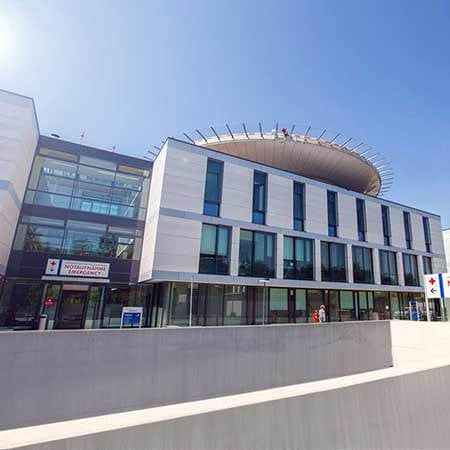Myelofibrosis is a condition of unknown origin characterized by red bone marrow fibrosis and impaired blood formation. The pathology is characterized by the formation of extramedullary (located outside the red bone marrow) foci of blood formation. Nevertheless, the produced cells are inferior. As a result, the person develops anemia, blood clotting disorders.
Content
- Symptoms and clinical course
- Diagnostics
- Treatment in Germany
- Organization of treatment abroad
Symptoms and clinical course
According to the 2008 WHO classification, myelofibrosis belongs to myeloproliferative neoplasms. It is associated with the transformation of the pluripotent hematopoietic stem cell, enhanced with the production of myeloid and stromal cells. This condition is characterized by both early and rapid progression of bone marrow fibrosis with the development of extramedullary foci of pathological hematopoiesis.
In 90% of cases, the disease develops after 40 years. At the time of diagnostics of this pathology, most patients are between 50 and 70 years of age. Myelofibrosis is diagnosed in young patients only in single cases. The average life expectancy of patients after the diagnosis is 5 years.
The symptoms develop gradually. The patient does not immediately seek help, and therefore myelofibrosis can be diagnosed only 1-2 years later after the onset of the disease. The size of the spleen helps approximately determine disease duration. In myelofibrosis, it increases by an average of 1 cm per year.
Initial symptoms:
- pallor;
- fatigue;
- loss of appetite;
- weight loss;
- fever;
- jaundice.
5% of patients do not have any symptoms. Their disease is diagnosed by chance, after the detection of an enlarged spleen. It can be quite impressive in size and often squeezes adjacent organs.
30% of patients are diagnosed with enlarged lymph nodes. The patients often complain of spontaneous bone pain. It may aggravate with palpation.
Diagnostics
There are various options of the course of the disease. The clinical form of myelofibrosis determines the changes that will be detected in the blood. The prevailing symptoms are also determined by them.
In total, there are 6 clinical forms:
- classic;
- thrombocythemic;
- anemic with and without reticulocytosis;
- erythemic;
- thrombocytopenic.
The classic form of myelofibrosis is characterized by moderate blood leukocytosis, increased number of neurophils, decreased levels of hemoglobin with a change in the form of erythrocytes. Platelet count is normal or slightly increased, while the appearance of platelets changes. There are often found giant forms of platelets.
Features of other clinical forms:
- The thrombocythemic form is characterized by the increased number of platelets due to their enhanced production. There also develops hypercoagulation and tendency to thrombosis.
- On the contrary, the thrombocytopenic form is characterized by the very low levels of platelets. There is a tendency to bleed.
- The anemic form may develop due to the bone marrow dysfunction. In this case, there is no reticulocytosis. If the mechanism of anemia development becomes the destruction of red blood cells (hemolysis), it results in the increased number of reticulocytes (young forms of cells) in the blood.
- The erythemic form is characterized by the increased levels of erythrocytes and hemoglobin, impaired microcirculation.
The diagnostics primarily involves the use of complete blood count, which may be a means to suspect the presence of oncohematological disease, as well as cytological bone marrow examination. To conduct it, the doctors make a biopsy. The bone marrow examination allows for the differential diagnostics with other myeloproliferative tumors.
Treatment in Germany
Conservative therapy does not allow cure myelofibrosis. The drugs that are currently used can only improve the quality of human life, reduce symptoms and increase life expectancy. Nonetheless, the disease will still progress and eventually lead to death.
The conservative therapy may involve the use of:
- cytostatic drugs (chemotherapy) in the myeloproliferative stage of the disease;
- glucocorticoids;
- transfusion of platelet and red blood cells at the stage of bone marrow failure;
- interferons;
- irradiation or removal of the spleen.
Complete cure of myelofibrosis can be achieved only with the help of allogeneic stem cell transplantation. This procedure is also called a bone marrow transplant from a donor.
The donor may be a close relative of the patient, if he has sufficient compatibility. The brothers and sisters are checked first of all. The probability of compatibility is about 25%. If not, one can use the donor base to search for suitable stem cells.
The transplantation is performed after preliminary preparation. As a rule, donor’s stem cells are obtained from blood. Then they are cultivated to obtain the required amount.
A patient with myelofibrosis undergoes high-dose chemotherapy. This therapy allows for a complete destruction of the remaining stem cells in the body. To reduce side effects, the patient undergoes symptomatic therapy, which is followed by stem cell transplantation performed under general anesthesia.
During the entire period of treatment, a person stays in the sterile isolation, as his immunity is completely destroyed and cannot resist infections for some time. However, the transplanted stem cells gradually begin to divide and produce the formed elements of the blood. Thus, the patient restores his immunity.
The treatment of myelofibrosis with stem cells has both advantages and disadvantages. The disadvantages are as follows:
- The high treatment costs (it costs about 200 thousand euros in Germany).
- The procedure is unsafe, since the mortality rate for patients under 35 years old is 5-10%, whereas for the elderly it reaches 30%.
- There is a risk of developing a graft-versus-host-disease in case of insufficient histocompatibility with the donor.
- There is a risk of developing infectious complications in the early postoperative period.
But all these disadvantages are outweighed by one significant advantage. Stem cell transplantation remains the only way to cure myelofibrosis. All other methods of therapy can only delay the approach of death.
Organization of treatment abroad
You can visit the best clinics abroad to get an adequate therapy for myelofibrosis. Booking Health can arrange a trip to Germany for you. German clinics perform stem cell transplantation. This country has a huge base of donors, and therefore each person can receive the best option in terms of histocompatibility.
Our services and benefits:
- We will choose for you the best clinic abroad, which shows good statistics in the treatment of myelofibrosis.
- The treatment costs will be significantly lower due to the absence of extra charges for foreign patients.
- We will establish communication with the doctors of the clinic and its administration.
- We will help control the treatment program.
- We will plan the program taking into account the previous examinations without their repeated conduction.
- We will ensure invoice verification with the return of unspent funds after the end of the program.
- We will help you purchase and send medicines.
- We will organize additional examination and treatment, if necessary.
Booking Health will also provide services, such as booking of the airline tickets and hotels, transfer from the airport to the clinic and back.
Authors: Dr. Nadezhda Ivanisova, Dr. Sergey Pashchenko










